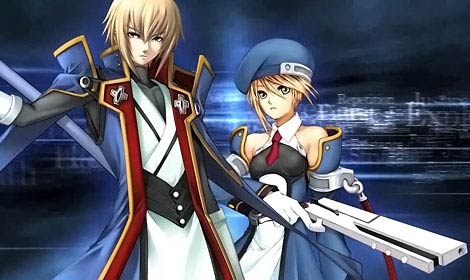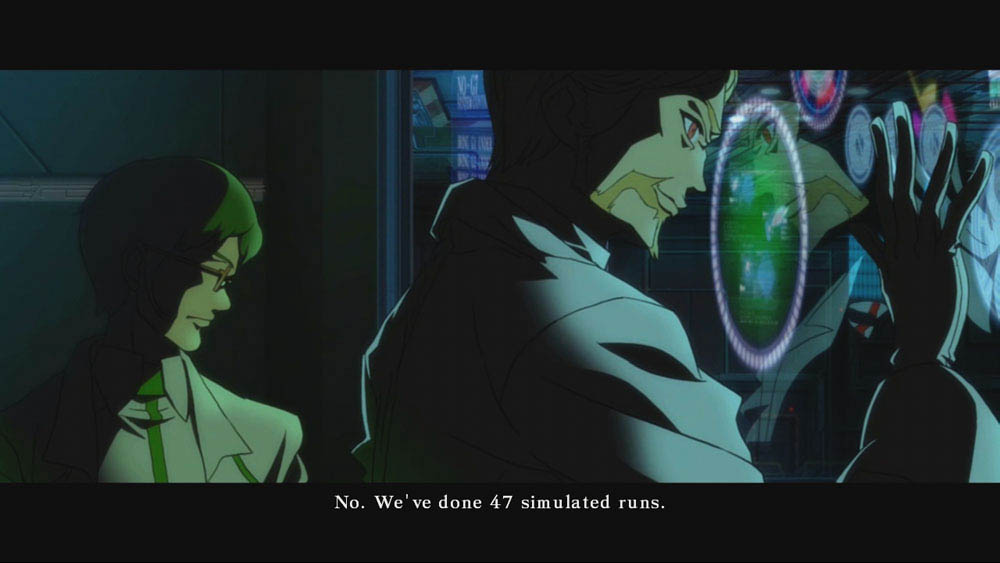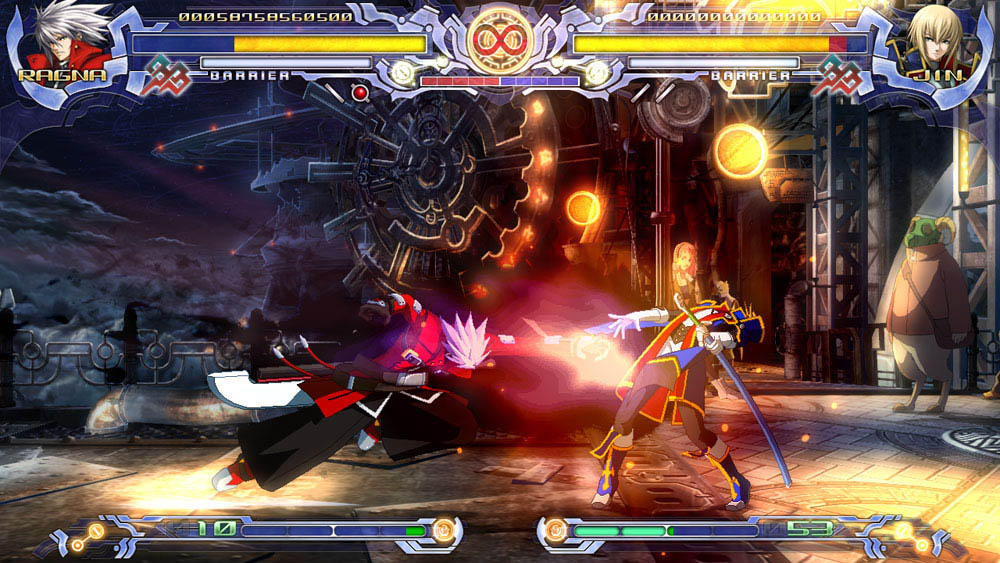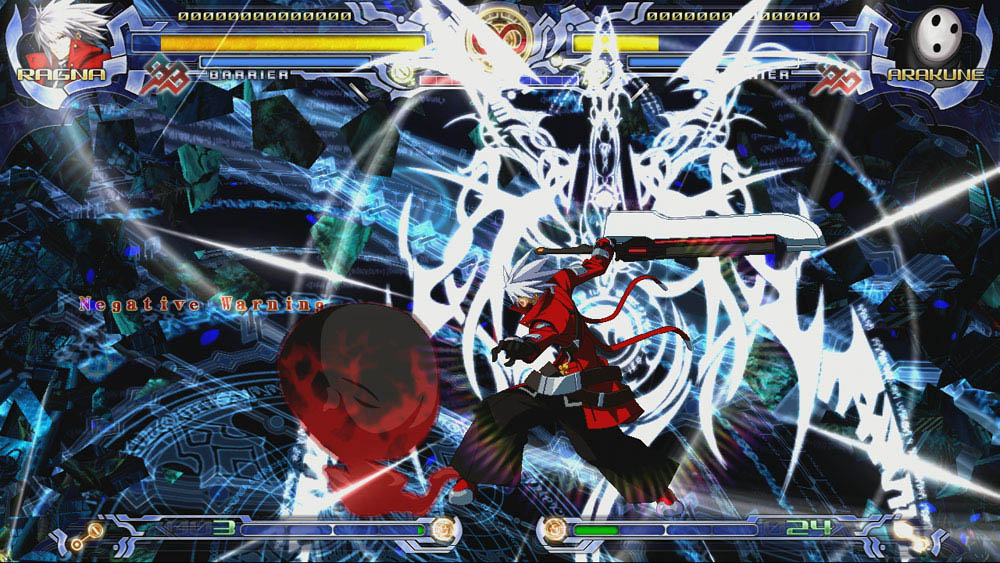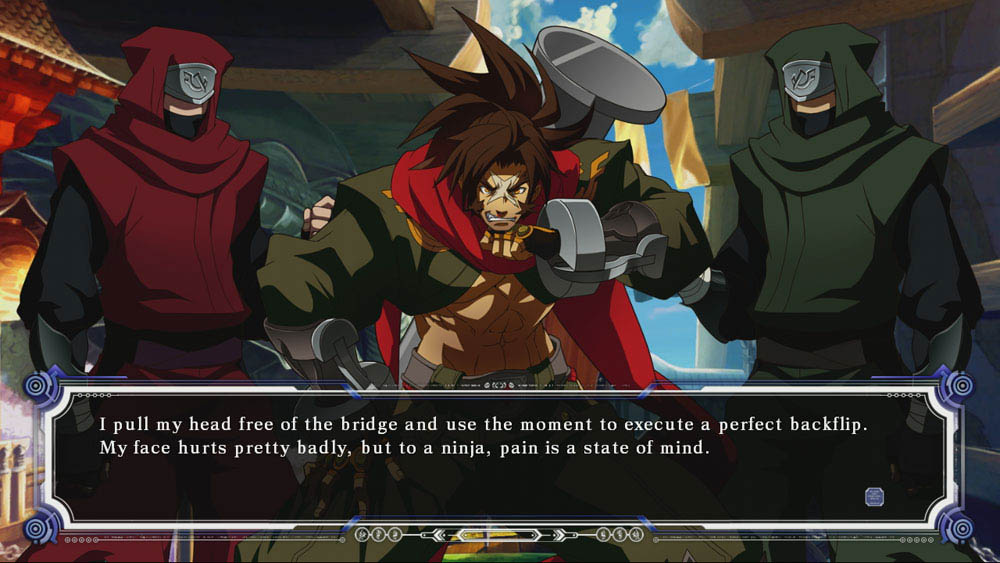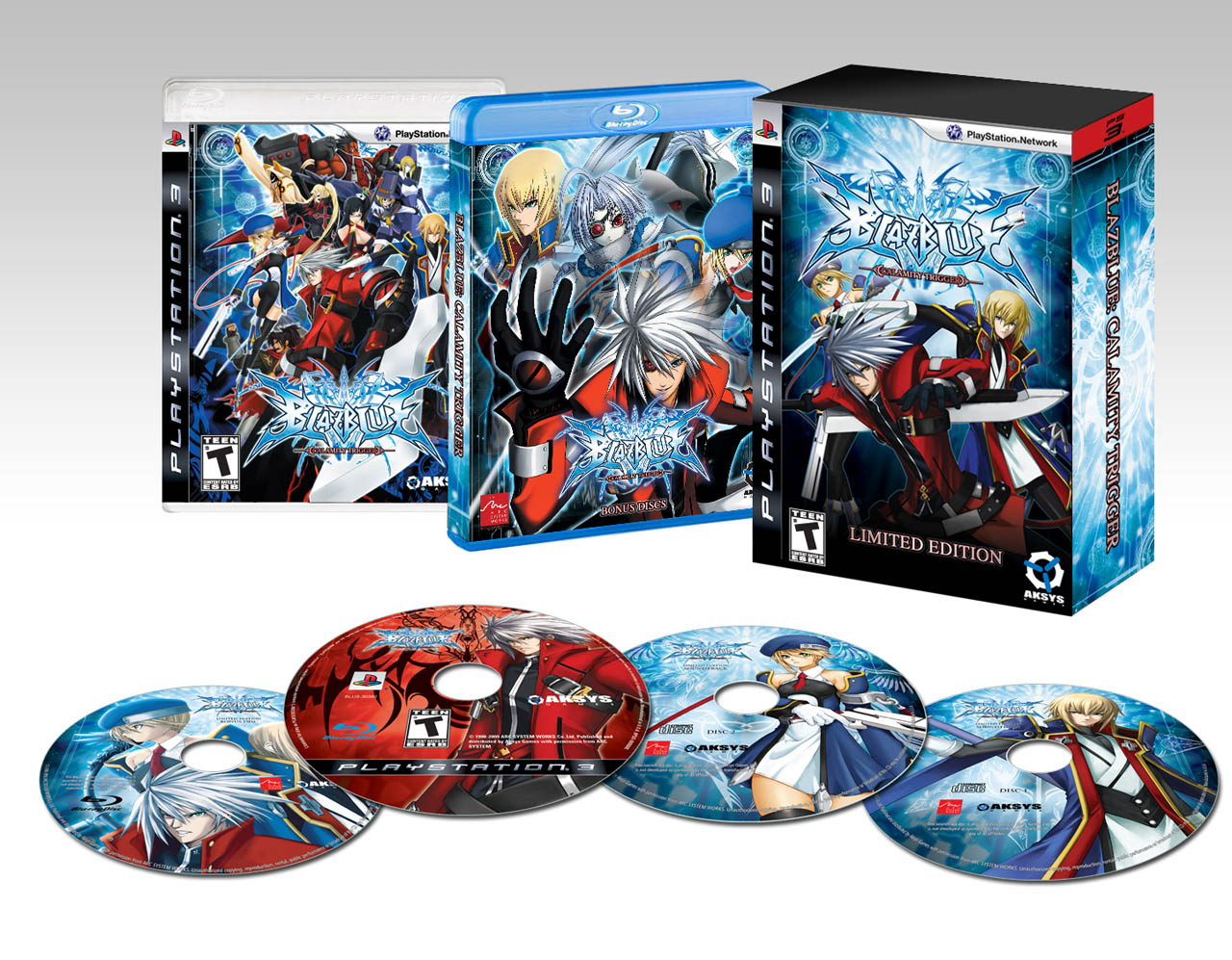The first high definition 2D fighting game, BlazBlue: Calamity Trigger is the spiritual successor to Guilty Gear; it features the same producer, designer, and music composer as its predecessor. Can it compete against other fighting games like this year's Street Fighter IV? Read this review to find out.
GraphicsAlthough they are only stills, the scenes in story mode look great. It plays out like a visual novel, with characters stills talking via a text box below them. Those scenes only make the prospect of an anime for BlazBlue more enticing. The only possible gripe regarding the story mode and animations is that studio Gonzo's rendition of the characters look slightly different from the original renditions, such as in the character select screen or in-game sprites. However, this is hardly a negative concern, because by no means does Gonzo's renditions look terrible – just different.
Sound
The music is an amazing upgrade from what already was almost a perfect soundtrack in Guilty Gear. In addition to the heavy metal that fans of Guilty Gear may be used to, the composers have included a variety of styles in musical composition. Tracks like “Under Heaven's Destruction” is reminiscent of the tracks in Guilty Gear, Carl Clover's theme is an interesting mix of jazz and heavy metal, while Taokaka's theme is poppy and resembles carnival music. Both of the latter themes, while departing from what fans may be used to, fit the characters and game.
Also included is an option to have either English or Japanese voices. Arc System Works satisfies gamers who like either English dubs or the original Japanese voices. Unlike most American dubs, however, the English voices in BlazBlue fit the characters and have a lot of expression. Fans will get a good laugh whenever Noel gets self conscious about her chest and Taokaka calls Litchi the “boobie lady.” This is one of the few games I've played where I could stand to leave the voices in English for a prolonged period of time.
The constant dialogue during fights also contributes to the anime-like tone of the game. Unlike slower, less hectic fighting games, the characters are constantly talking. Whether they're dashing, jumping, or doing a move, they'll shout out lines like “Take this!” or “Do you hate me, Ragna?” rather than the usual grunts heard in other games. Some may find them annoying, but they make the game feel lively and exciting, just like a fight out of an anime.
Gameplay
BlazBlue stands out amongst other fighting games with its simple, yet challenging system. The game only uses four buttons: A, B, C, and D. A, B, and C represent the weak, medium, and strong attacks, and D is the Drive button. While the first three are self explanatory, the Drive attack has a unique effect for each character. Ragna's Drive attacks allow him to absorb ten percent of any damage he deals, while Jin's will freeze the enemy, creating bigger, more damaging combos. Drive attacks succeed where Street Fighter IV failed – giving instant gratification to new players. The Drive attacks are spectacular to watch, have interesting effects, and don't require any execution to pull off. Ultras, while exciting to watch in Street Fighter IV, require execution and patience from new players; it fails to give the instant gratification that inexperienced players want.
Instead of reducing BlazBlue to a button masher, however, the drive button actually adds depth to gameplay. The drives are not abusable attacks for the most part and require strategy to use. A Ragna player mashing on the Drive button, hoping to constantly replenish health will not get far against another Ragna player who has a strategy and is knowledgeable about combos. This means that the Drive button, while a good source of instant gratification for new players, is just another attack button that players must learn to utilize.
Like Guilty Gear before it, BlazBlue's characters are all unique. Every character has a totally different set of moves and play-style – you can't play one like you would another. From Arakune's curse, which releases projectiles at enemies every time the player releases a button, to Litchi's two movesets, which changes based on whether or not she has her staff, every character plays completely differently. This provides a breath of fresh air for players and gives every character an interesting trait.
At the competitive level, this game is exciting. Combos take off an average of 30 to 40 percent of another character's life. The constant danger of losing that much life off of a single mistake is an excitement unparalleled by any other fighting game, except maybe Guilty Gear or Marvel vs Capcom 2. While you can still deal out big damage in other fighting games, Guilty Gear, Marvel vs Capcom 2, and BlazBlue are the few games where opportunities to cripple the opponent are always available - with or without super meter or heat gauge.
Barrier burst is another element taken from Guilty Gear; by pressing all four buttons, the player will cause the character to “burst,” pushing away the opponent and giving him some breathing room. Once used, however, the player will lose barrier block for the rest of the round and take significantly more damage. This is another strategic decision that players must make. Should they burst early and keep an offense going? Or should they save it until absolutely necessary to avoid taking extra damage?
Story Mode
Fighting games weren't meant to have stories, but they all tend to have one these days. They also tend to suck. BlazBlue avoids that problem with a decent story mode that utilizes all of the different characters. Taokaka, who always calls Litchi the “boobie lady,” is always entertaining to watch. Even Rachel, who is always pompous and nonchalant, has more than her fair share of entertaining moments. However, the story mode isn't just filled with funny lines; for those interested, a fascinating background and a dramatic story awaits players.
The story mode has a good amount of replay value. Unlike Guilty Gear's linear story mode, every character has several different endings based on decisions players make, whether or not they finish the match with a “Distortion” or “super” move, and whether or not they lose. These choices affect the player's path. After playing through Litchi's story mode three separate times, I was still only at 86%. Imagine how much you can do with the whole cast. This fleshed out story mode puts every other fighting games' stories to shame.
Being Able to Play Someone in New York in my Underwear
Considering that arcades are practically dead and not everyone plays fighting games, online play is essential to fighting games. Prior to this game, Super Street Fighter II Turbo HD Remix had the best netcode, allowing some players with good connections to play from coast to coast without lag. Even in that game, however, there would be occasional “rollback lag,” causing characters to “teleport” and jitter around, destroying the flow of the game. That never happened in Street Fighter IV, but for that game, the net code simply delayed inputs from players to make sure the game ran fine. This made some combos impossible. BlazBlue, however, gets it right and provides optimal coast to coast play. Before a match starts, the game moves in slow motion, synchronizing the two players. Once that is done, the game runs incredibly smooth. This is the best way to play online.
In addition to great netcode, Arc System Works practically included every possible feature fans wanted: voice chat, double blind select in ranked matches, and even lobbies supporting up to six players. These features encompass everything short of holograms of the opponent.
However, it seems puzzling for the game to have double blind select in ranked matches when the game shows the other player's ID card, which displays his main and sub character, right before the match. In some way, it makes double blind select pointless. Also, I cannot begin to describe how many times I've tried to join a lobby only to see that it is full, refresh the list of lobbies, and still see that same lobby there. It's only natural to stop displaying any lobbies that are full; it was odd to see a minor mistake like this when everything else was almost perfect. These two are only minor gripes though, and should not stop anybody from enjoying the online play.
Limited Edition Bundle
An additional soundtrack and instructional Blu-ray or DVD is included for those who bought this game during its initial run, or buys the remaining copies at their local game store. Unlike the usual soundtrack that comes with collector's copies of games or as reservation bonuses, this is a complete soundtrack with two discs and 42 tracks – enough to satisfy any BlazBlue fan.
The other part of this bundle is the most notable; the instructional disc was created with help from some of Southern California's top BlazBlue players like Earl “render” Gertwagen and Ken “kenyon” Tsuji, amongst others. The tutorial covers everything from the basics, like attacks, to all the characters' combos and strategies. Much like Street Fighter IV's challenge mode, the tutorials introduce players to BlazBlue and hopefully get them to a competitive level. Exclusive to the American release, the tutorial goes an extra step beyond Street Fighter IV's challenge mode and provides video demonstrations of all the combos and strategies. The video demonstrations show players how a specific combo or strategy should be executed, rather than leave it to trial and error. This is helpful for anyone who wants to get out of the “newbie mashing on drive” stage.
However, it is somewhat annoying to find this feature on another disc. Instead of being able to access it easily, most players will have to stop playing the game to watch the disc, unless they somehow have another TV in the same room with a Blu-ray or DVD player. This hindrance makes it inconvenient for anybody learning the game; but it is a minor setback if one truly wants to learn it. Hopefully, the video tutorials can be combined with the game disc in the future. It would be even better if something like Street Fighter IV's challenge mode had video demonstrations like the tutorial disc included here. That's a hint for both Arc System Works and Capcom.
Greatest Fighting Game of this Generation?
As of right now, BlazBlue is probably the best fighting game of the generation. Featuring beautifully drawn, high definition sprites, a great soundtrack, and fun gameplay for both new and seasoned players, BlazBlue can satisfy just about anybody. Even if you don't like the BlazBlue's style, you have to recognize that its online options and tutorial disc are almost groundbreaking for all fighting games. The minor gripes mentioned do little to take away from BlazBlue; it truly is an amazing game that no fighting gamer should miss out on. The lengthy efforts Arc Systems went through to satisfy its fans is something that every company should aspire towards and fans should appreciate.
Score: 5 Giis/5

